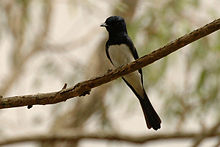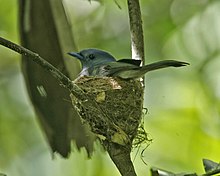Monarch flycatcher
| Monarchidae | |
|---|---|

| |
| Mascarene paradise flycatcher (Terpsiphone bourbonnensis) | |
| Scientific classification | |
| Domain: | Eukaryota |
| Kingdom: | Animalia |
| Phylum: | Chordata |
| Class: | Aves |
| Order: | Passeriformes |
| Superfamily: | Corvoidea |
| Family: | Monarchidae Bonaparte, 1854 |
| Subfamilies | |
| |
| Synonyms[1] | |
| |
The monarchs (family Monarchidae) comprise a family of over 100 passerine birds which includes shrikebills, paradise flycatchers, and magpie-larks.
Monarchids are small insectivorous songbirds with long tails. They inhabit forest or woodland across sub-Saharan Africa, south-east Asia, Australasia, and a number of Pacific islands. Only a few species migrate. Many species decorate their cup-shaped nests with lichen.[2]
Taxonomy and systematics
Some of the one hundred or more
With the new insights generated by the
More recently, the grouping has been refined somewhat as the original concept of Corvida has proven paraphyletic. The narrower 'Core corvine' group now comprises the crows and ravens, shrikes, birds of paradise, fantails, monarchs, drongos, and mud nest builders.[7]
The monarchs are small to medium-sized insectivorous passerines, many of which hunt by flycatching.
Taxonomic list
The monarch family has fifteen genera as follows:[8]
FAMILY MONARCHIDAE
- Subfamily TerpsiphoninaeRangareddy district of Andhra Pradesh, India.
- Genus Hypothymis (4 species)
- Genus Trochocercus (2 species)
- Genus Terpsiphone– typical paradise flycatchers (17 species)
- Subfamily Monarchinae
- Genus Chasiempis(3 species)
- Genus Pomarea (9 species of which 3 extinct)
- Genus Mayrornis (3 species)
- Genus Neolalage – buff-bellied monarch
- Genus Clytorhynchus– shrikebills (5 species)
- Genus Metabolus – Chuuk monarch
- Genus Symposiachrus (21 species)
- Genus Monarcha (9 species)

Black-faced monarch - Genus Carterornis (4 species)
- Genus Arses(4 species)
- Genus Grallina – magpie-larks (2 species)
- Genus Myiagra – broad-billed flycatchers (20 species of which 1 extinct)

Broad-billed flycatcher
- Genus
Description
The monarchs are a diverse family of
Distribution and habitat

The monarchs have a mostly Old World distribution. In the western end of their range, they are distributed through sub-Saharan Africa, Madagascar, and the islands of the tropical Indian Ocean. They also occur in South and Southeastern Asia, north to Japan, down to New Guinea, and most of Australia. The family has managed to reach many Pacific islands, and several endemic genera occur across Micronesia, Melanesia, and Polynesia as far as Hawaii and the Marquesas.
The paradise flycatchers of the genus monarchs, which are exclusively Polynesian in origin.
The majority of the family is found in forests and woodland habitats. Species that live in more open woodlands tend to live in the higher levels of the trees but, in denser forest, live in the middle and lower levels. Other habitats used by the monarchs include savannahs and mangroves, and the terrestrial magpie-lark occurs in most Australian habitats except the driest deserts.
While the majority of monarchs are resident, a few species are partially
Breeding

The monarchs are generally
References
- ^ "Monarchidae". Integrated Taxonomic Information System. Retrieved 26 March 2021.
- ISBN 1-85391-186-0.
- ^ Roberson, Don (9 March 2012). "Monarchs". creagrus.home.montereybay.com. Retrieved 5 April 2021.
- Ahlquist, Jon Edward(1990): Phylogeny and classification of birds. Yale University Press, New Haven, Conn.
- ^ Christidis, L.; Boles, W. E. (1994). The Taxonomy and Species of Birds of Australia and its Territories. Melbourne: RAOU.
- ISBN 978-0-643-06511-6.
- ISBN 0-19-517234-5.
- . Retrieved 1 August 2021.
- ^ Duston, Guy (2006). "The Pacific shrikebills (Clytorhynchus) and the case for species status for the form sanctaecrucis" (PDF). Bulletin of the British Ornithologists' Club. 126 (4): 299–308. Archived from the original (PDF) on 2009-01-05.
- .
- .
- del Hoyo, J.; Elliott, A.; Christie, D., eds. (2006). Handbook of the Birds of the World, Volume 11: Old World Flycatchers to Old World Warblers. Barcelona: Lynx Edicions. ISBN 84-96553-06-X.
External links
- Monarch flycatcher videos on the Internet Bird Collection


